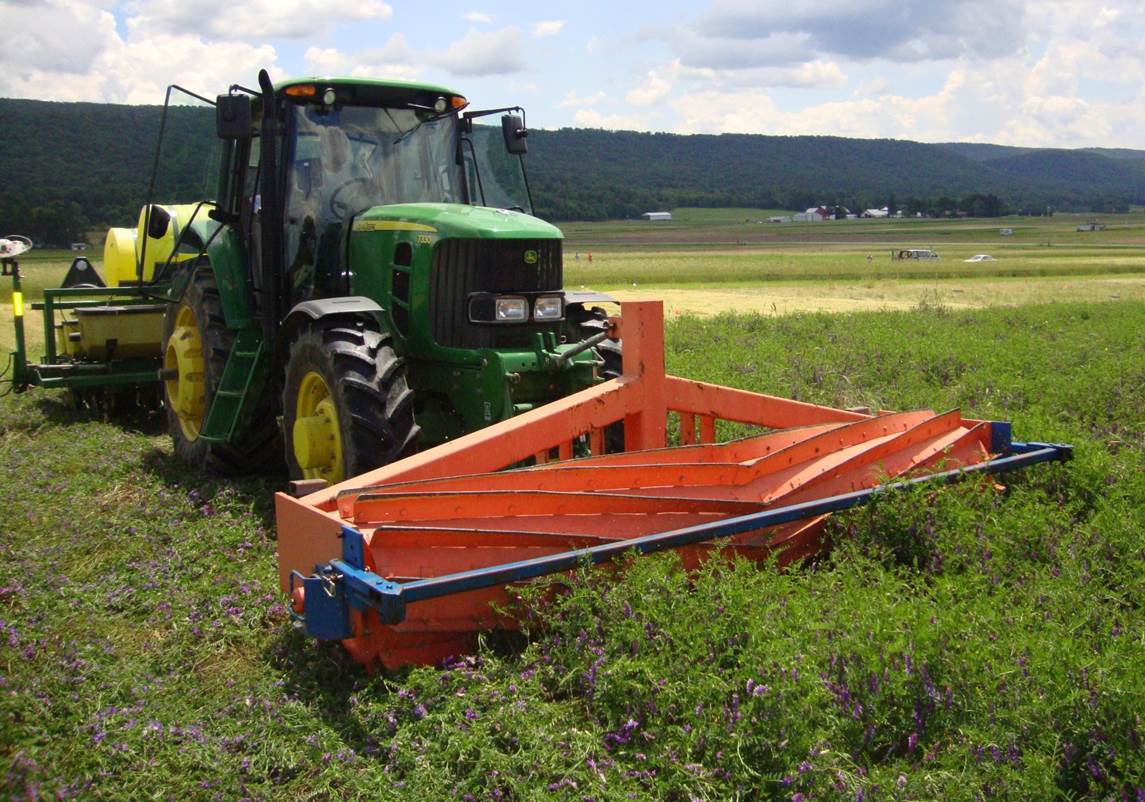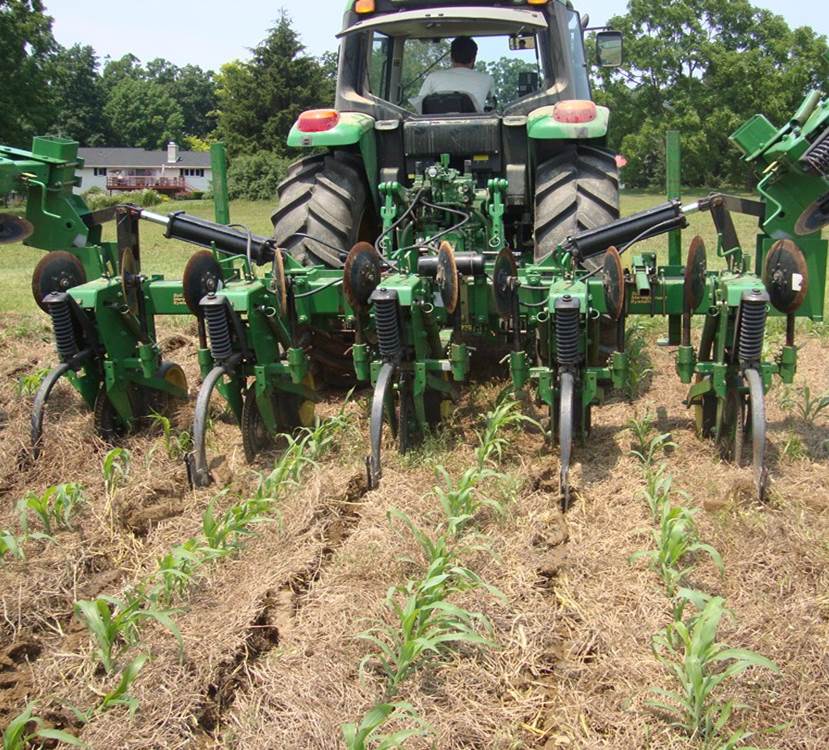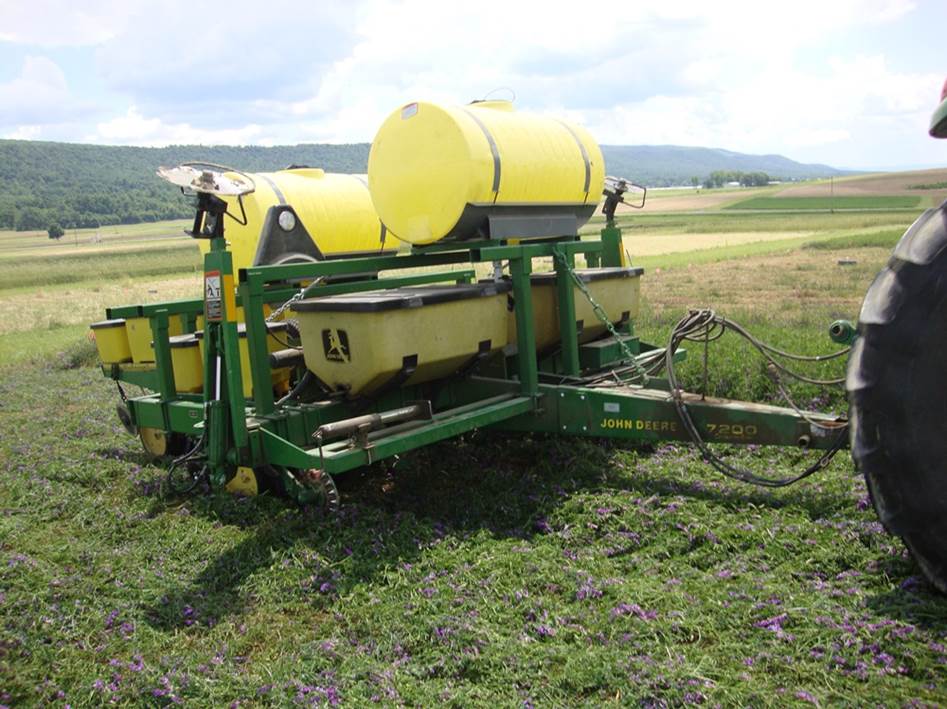by Mark Dempsey, CFSA’s Farm Services Coordinator | Feb. 5, 2016 –

With February here, most growers are spending their time out of the field planning next year’s crops, making now a great time to take a step back to assess soil conservation on the farm.
We all want to treat our soil well, keep it on the farm, and maintain or increase fertility. The current, best practices to increase your soil fertility and reduce erosion are to decrease the amount you till and increase cover cropping. The best option is to try to integrate both of these practices to the extent possible on your farm.
Interestingly, reducing tillage and incorporating cover crops go hand-in-hand, since cover crops can replace one important role of tillage: cover crops can be used to suppress weeds, eliminating the need for spring tillage and later cultivation if done properly and all goes well. That said, implementing herbicide-free, low-till practices, and incorporating more cover crops into your crop rotation requires knowledge, skill, and the addition of new tools to your toolbox. These tools are both implements to pull behind your tractor and management strategies. For example, you can eliminate spring tillage before your summer cash crop by growing a fall-planted, weed-suppressive cover crop that can be roll-killed, rolling it down at the appropriate time, and no-till planting your cash crop into it. To do this, you might need to revamp your crop rotation to include a roll-killed cover crop, learn about its management, and, mostly likely, acquire a couple pieces of equipment. The knowledge and skill to do this well takes time to develop, and it will likely take many years to acquire the full suite of necessary implements. But, it is certainly worth the investment: your dividends will be paid out in healthy, fertile soil that stays put on the farm.
Integrating No-till and Cover Crops

A good starting point is to follow a roll-killed, fall-planted cover crop with a no-till planted cash crop. The two most common roll-killed cover crops are cereal rye and hairy vetch, however similar crops can also work if they survive the winter in your area: triticale, barley, oats, winter pea, and crimson clover. Legume cover crops have the added benefit of supplying nitrogen to the subsequent crop. The cash crop can be a summer grain, such as corn or soybean (soybean is usually more successful), or summer vegetable crop, such as tomato, snap bean, or a summer cucurbit. There are several requirements you’ll need to meet to be successful:
- First, you’ll need to manage your cover crop as if it were a cash crop: timing, fertility, and good establishment are critical for success. Be sure to get things started early enough in the fall to have a well-established cover crop going into winter. You may need to modify your crop rotation slightly, choose an early maturing cash crop variety, or find a way to establish your cover crop while the cash crop is in the field. Generally, fertility is applied in the fall before cover crop planting.
- Second, you’ll need a relatively weed-free field. Start in the field with the lowest weed population. This is simply because your chemical-free weed control options are limited if you won’t be tilling or cultivating, and it’s best to avoid the problem from the get go.
- Third, you’ll need a way to manage your cover crop once it’s established, which puts on a lot of biomass and can be quite challenging.
Managing Your Cover Crop
Start with the right equipment: a roller-crimper or similar implement to lay down and kill your cover crop and the right planting equipment to get through the cover crop once it’s down. Flail mowing your cover crop is also an option, but, generally, weed suppression is not as good, and some cover crop species/varieties regrow from their base, creating problems later. Bush hogging is not recommended.
The timing of rolling is just as important: cover crops need to be in the late flowering to early seed-set stages – the later the more susceptible to roll-killing, although the tradeoff is more mature cover crop seed, which can germinate and become weedy if given the chance. If you roll too early the cover crop usually bounces back and takes a while longer to flower again, ultimately delaying cash crop planting. I have seen failed attempts at managing hairy vetch that put winter squash planting at the end of July.

Next, a planter or transplanter equipped with residue managers is important for moving the cover crop out of the way for planting, and it must be heavy enough for the coulters or hole punchers to cut into the denser, un-tilled soil.
Remember, once your cash crop is established your options for weed control are limited, so shoot for as much cover crop biomass as your equipment can handle. Planting more than one cover crop species can increase total biomass, although you need to be sure they mature at the same time. Inter-row cultivation is possible with the right equipment: a high residue cultivator has one broad sweep between each row that travels an inch or two under the soil, undercutting weeds, and only minimally disturbs the cover crop residue. Flame and other weeding may work under certain conditions. Management after cash crop harvest is typically moldboard plowing, but, with the right equipment, this indeed could be modified so that the next cover or cash crop can be no-till planted (eg. a manure injector, inter-seeder, no-till drill, or whatever suits your rotation).
By simply taking a step back, looking at your rotation, and evaluating where and how changes can be made, you can reduce tillage and increase cover cropping incrementally in your cropping system. By doing so you’ll continue to build healthy, productive soil, and help keep your soil on the farm.
Did you know: Many of the practices addressed here may qualify for financial assistance through NRCS’s EQIP Organic Initiative if you’re a transitioning or certified organic producer.
CFSA can write you a Conservation Activity Plan (CAP 138). A CAP 138 also provides the nuts-and-bolts of your Organic System Plan for organic certification. Contact Mark Dempsey or your local NRCS District Conservationist.
All photos by Clair Keene


